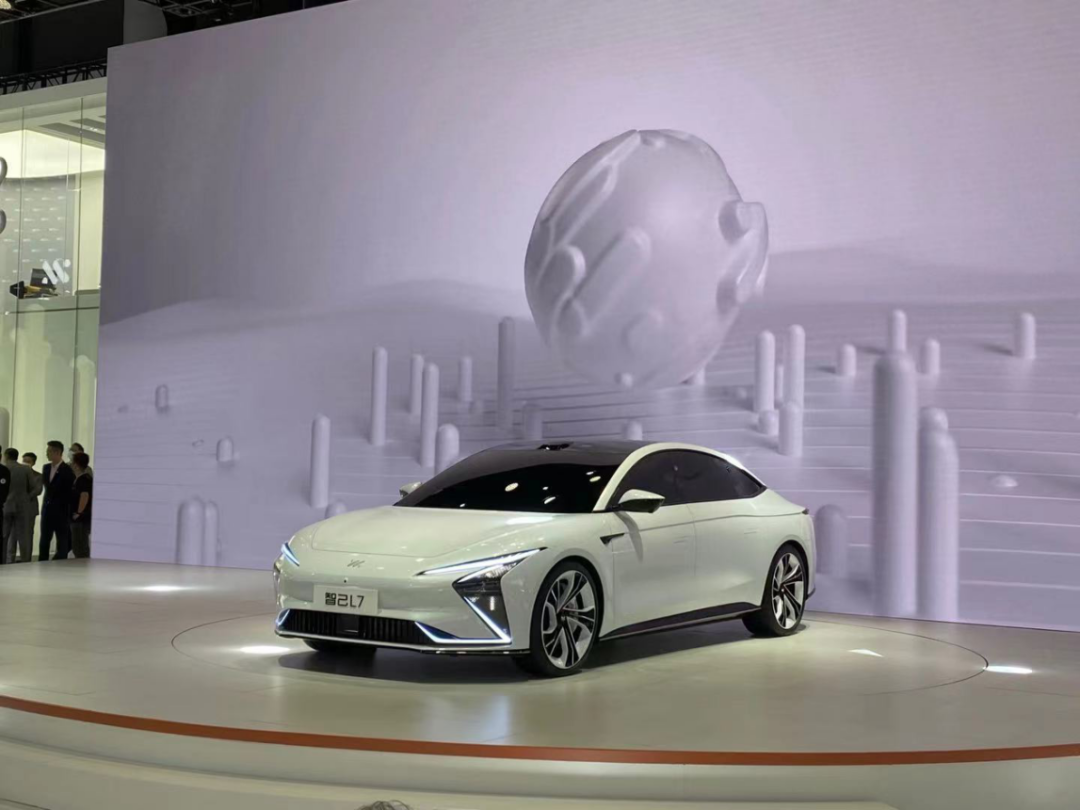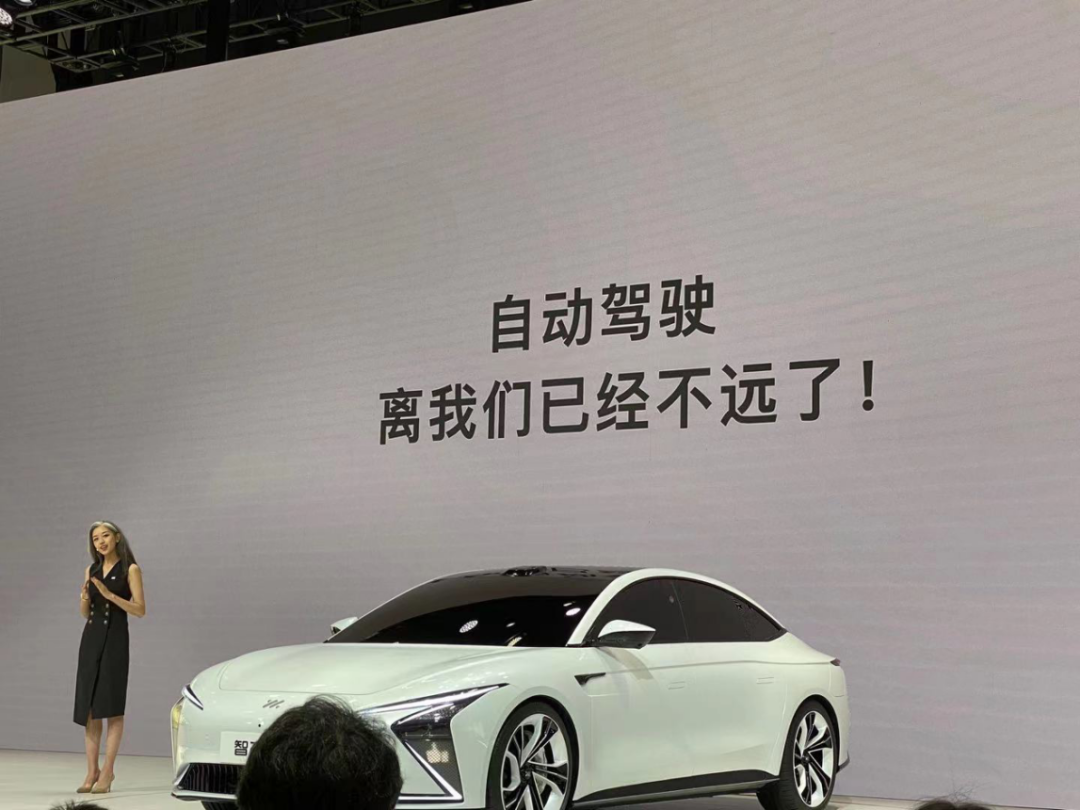*This article is reprinted from the autocarweekly public account
Author: Karakush
At the Chengdu Auto Show Media Day the day before yesterday, the only product on display was the IM L7, which has not yet entered mass production, surprising everyone.
One of the highlights is that their engineering test car, equipped with the IM AD intelligent driving system, has successfully tackled the evening rush hour on the Third Ring Road and Second Ring Road of Chengdu.
In the past two or three months, IM IM AD has undergone multiple rounds of testing on complicated roads in first and second-tier cities. Some time ago, Autohome released a video of IM IM AD driving for 40 minutes with zero takeovers in downtown Shanghai, which many friends may have seen.
And the video of Chengdu displayed on site demonstrates similar capabilities: the driver lightly touches the steering wheel, while the system automatically handles complicated scenarios such as merging on and off ramps, congested traffic, close-range cutting-ins, large-radius U-turns, obstacle recognition, and merging into the main road.
For example, when encountering a close-range cut-in from a left-turn vehicle without signaling, IM IM AD can recognize the movement of the front car, reduce speed slightly, turn slightly to the right, avoid the obstacle, then return to the center of the lane.
In another example, when wanting to merge from the left lane onto the main road, with constantly moving vehicles on the main road and obstacles appearing on the planned route, IM IM AD can recognize this and slow down in advance, not being affected by virtual or solid lane markings, probe obstructions bit by bit, and eventually successfully merge before reaching the obstacle.
IM had previously released IM AD and top brand comparison test data: in terms of average takeover distance, top brands covered 17.43 kilometers, while IM covered 240 kilometers, leading by a factor of 14; in terms of takeover distance caused by cutting-in, top brands covered 170 kilometers, while IM covered 969 kilometers, leading by a factor of 5; in terms of on and off ramp success rate, top brands achieved 52.94%, while IM reached 99.3%.
“At least in these three dimensions, IM has already surpassed the industry’s top players.”
They claim to “solve the pain points of commuting congestion for Southwest users and bring faster and more reassuring hope.”
This was a very fitting trend for 2021. Until July, there was still a strong momentum towards the year of mass production of advanced autonomous driving.
However, now that they have touted intelligent driving in such a high-profile manner, it seems somewhat “risky”.In August, there was a tragic accident involving this kind of technology from a domestic competitor in China. Afterward, the industry rallied for the establishment of clear industry standards, causing car companies that were once proud of their “automation” to change their rhetoric to ambiguous and harmless language such as “intelligence” and “assistance,” and to walk a fine line with low-key advertising.
At the same time, across the ocean, the National Highway Traffic Safety Administration (NHTSA) in the United States began investigating Tesla’s Autopilot system, as there have been multiple traffic accidents involving Tesla in AP mode since 2018.
For a time, arguments such as “I knew this technology wasn’t reliable” regained ground. The opposition is not just focused on overly confident advertising, but also calls for careful consideration before pushing immature and unsafe technology onto the market, and even believes that current regulation of technology development is too relaxed. The situation is the same both at home and abroad.
In my opinion, the vast majority of “machines can’t be trusted” are unfounded predictions from the public, similar to the belief of foreign grandmothers that washing machines will never clean as well as hand washing, stemming from inertia, conservatism, and lack of imagination, and not worth discussing. Even now, there may be one or two machine wash failures that cannot be fought against, which might prove those predictions to be correct. So what?
Of course, now there are some reasonable questions being raised about the boundaries of autonomous driving capabilities.
For example, CEOs and engineers in the industry believe that for relatively weak systems, autonomous driving capabilities can be developed through accumulating enough mileage and enough corner cases.
And if we look at artificial intelligence and machine learning – the core technology of autonomous driving – from this perspective, data cannot make up for some fundamental flaws, or perhaps cannot make autonomous driving completely reliable and safe in our lifetime.
Machine learning can be roughly divided into four layers. The most basic is skill reasoning, such as the ability of today’s intelligent cars to queue up and travel on highways. The next layer is rule-based reasoning, which is the ability to determine what to do when encountering certain road signs, signal lights, or cut-ins, which is also a function that is currently available in many products on the market.
The third layer is knowledge-based reasoning, which involves being able to recognize, for example, a partially obscured sign and determine what it is, or being able to recognize that traffic lights might look different in different cities.
The highest level is what we expect, which is the ability to safely complete a journey by synthesizing knowledge, experience, and skills when thrown into a completely new scenario. For human driving, this is no problem -For autonomous driving, problems arise from the third level upwards. Even the products that are highly praised on the market cannot achieve complete reasoning about the world based on knowledge. They generally have excellent pattern matching capabilities, but their ability to extend and generalize is extremely limited, let alone to apply cross-domain experience.
For example, they may recognize a snowman by the roadside as a potential pedestrian, but cannot judge that it is an inanimate object that cannot cross the road. This explains why the same accident cause cannot be avoided, and you cannot “teach” a machine once and for all.
This reflects the classic Moravec’s Paradox. It is relatively easy to make a computer play chess, but it is difficult, if not impossible, to make it perceive and act like a one-year-old. You can teach a toddler not to touch dangerous electrical sockets, but it is challenging to teach a machine what all sockets are. This process is called an algorithm.
Therefore, in the academic community’s opinion, the breakthroughs in machine learning over the past few decades have only produced the most primitive “intelligence”. This brings up the question of whether, based on a little achievement in intelligent driving, we have made the “first step fallacy” in imagining autonomous driving like a monkey jumping to the moon.
Industry, of course, holds a different view. The industry believes that this matter can be divided into several subsystems through engineering methods, such as using redundant mechanisms and massive data to cover as much knowledge as possible; using high-precision maps to fill gaps in sensor data. Now, most companies at the forefront are doing this.
Smart Edge, or its technology provider Momenta, also has a data-driven algorithm as an advantage, from perception to prediction, to fusion, regulation, and all technical modules, all process data-driven. Smart Edge Automotive Co-CEO Liu Tao introduced that this is very advanced in the industry, and we should be the first company to achieve full-process algorithmic intelligent driving capabilities.
This advantage will be further amplified after the official mass production. When encountering corner cases in some complex scenarios, it can also achieve rapid iteration. “Based on massive data, data-driven algorithms, and a complete data-based tool chain–you can understand it as a data factory–based on these three factors, we can form the ability of rapid iteration and evolution. In this respect, we work with SAIC to complete the co-creation of the Smart Edge IM AD product.”When asked about recent accidents in the industry, Liu Tao remained silent but expressed Smartisan’s stance. Today’s mainstream autonomous driving is essentially advanced driver assistance. Consumers are not yet at the stage where they really need autonomous driving. What they really care about is whether they can minimize the time spent on driving and maximize the comfort level on their daily commutes from work to home when encountering traffic jams.
At least for the next three to five years, we will still be in a state of human-machine co-piloting. Many people see this as a pseudo-proposition of “autonomy”, but it is obvious that we cannot skip this stage. Both automakers and regulatory agencies have to consider, under this premise, what they can do besides giving a suitable name to the imperfect autonomous driving technology.
Smartisan’s plan is to strengthen communication between humans and machines, such as IM AD “Trust Enhancement” system, which will display graded warnings via Wi-Fi, making takeovers predictable, while also alerting users via multi-modal interaction such as screens, voice, sound, DLP digital projector headlights, and seat belt vibration to avoid unexpected experience interruptions.
Until the first half of this year, I would attribute all the highlighted “humanization” tendency to the fact that the technology is not hardcore enough to provide a seamless experience. But now it seems that it may be necessary to lower some expectations. Under existing technical conditions, safety and experience are delicately balanced, and the difficult process of moving forward is an inevitable path to achieving the goal. Otherwise, it’s just ground-level stuff.
Returning to Smartisan’s news…

At the Shanghai Auto Show in April, Smartisan L7 launched the “Angel Round Edition” pre-sale. In fact, it is an exclusive benefit for founding reservation car owners, including user data rights and interests feedback plan. Upon reaching certain conditions, they can redeem soft and hard hardware upgrades such as next-generation LiDAR or next-generation advanced energy batteries. This is still a cost that hurts.
During the Chengdu Auto Show, the remaining 800 places will be released. A total of 3000 places have been made available in previous batches, and all 2200 places have been sold out. After the “Angel Round Edition” ends, there will be plans for rounds A and B.
A small batch will be put into production at the end of this year for testing and internal testing purposes, with the possibility of a large-scale production after the turn of the year. Specific time points will be provided by Smartisan based on the progress of product development, after-sales service rights and interests, and production status at the time. The goal is to achieve To C delivery between the end of February and March next year.
This article is a translation by ChatGPT of a Chinese report from 42HOW. If you have any questions about it, please email bd@42how.com.
